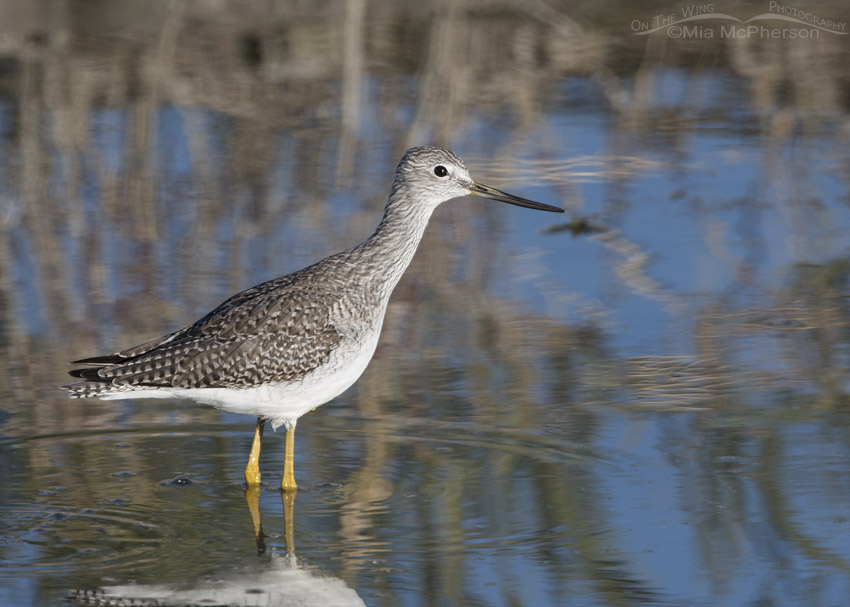 Autumn Greater Yellowlegs – Nikon D500, f7.1, 1/1600, ISO 400, -0.3 EV, Nikkor 500mm VR with 1.4x TC, natural light
Autumn Greater Yellowlegs – Nikon D500, f7.1, 1/1600, ISO 400, -0.3 EV, Nikkor 500mm VR with 1.4x TC, natural light
Yesterday I saw a post on Facebook that showed a a photo of a Greater Yellowlegs in open water in a snow storm and the person posting the image voiced their concerns about the well being of the shorebird in winter conditions. They also wondered if they should attempt to catch the yellowlegs and take it to a rescue group.
The Greater Yellowlegs in the photo appeared healthy, active, and was probably foraging for prey despite the snow that was falling.
Here in northern Utah it isn’t all that unusual to see Greater Yellowlegs into December with several inches of snow on the ground and then start seeing them again in February in pretty much the same conditions. As long as there is open water it doesn’t really surprise me to see them during the winter.
The Greater Yellowlegs in the photo above was photographed on November 18, 2016 at Farmington Bay WMA and by that time we had had temps well below freezing and snow on the ground.
 Winter Wilson’s Snipe in snow – Nikon D500, f8, 1/1000, ISO 200, +1.0 EV, Nikkor 500mm VR with 1.4x TC, natural light
Winter Wilson’s Snipe in snow – Nikon D500, f8, 1/1000, ISO 200, +1.0 EV, Nikkor 500mm VR with 1.4x TC, natural light
Other shorebirds that I see into the winter months in Utah are Killdeer, American Avocets, Long-billed Curlews, and Wilson’s Snipe.
This Wilson’s Snipe was photographed on December 26, 2016 at Farmington Bay WMA and there were several inches of snow on the ground at that time and date. As I recall there were three or four two snipe in the same area that morning.
(Corrected after I researched my photos from that morning. I feel that it is my duty to be accurate and to adhere to the facts when writing about what I see in the field, to do less than that is disingenuous at the least and dishonest at the worst end of the spectrum.)
 Late October Greater Yellowlegs at Farmington Bay – Nikon D500, f7.1, 1/2000, ISO 500, Nikkor 500mm VR with 1.4x TC, natural light
Late October Greater Yellowlegs at Farmington Bay – Nikon D500, f7.1, 1/2000, ISO 500, Nikkor 500mm VR with 1.4x TC, natural light
This Greater Yellowlegs was also photographed at Farmington Bay WMA on October 30, 2018.
Being concerned about shorebirds in harsh winter weather isn’t unusual but despite their delicate appearance these shorebirds are tough. They also know instinctively when it is time to head to warmer locations where there is open water for foraging.
However; if there were signs that a late migrating shorebird had a broken wing, didn’t fly on close approach, or looked unhealthy and in distress I’d attempt to capture it and get it to a rehab or rescue group as soon as possible.

October 25, 2020
As I write this post this morning I can see that snow is heading in the direction of where I live on the weather map and I might see it on the ground for the first time this season. I know for sure I will be seeing snow-capped mountains when the sun rises over them.
Update: There is snow on the ground and on my Jeep!
Life is good.
Mia
Click here to see more of my shorebird photos.
Note: Some of North America’s shorebirds start fall migration in late June and July, some migrate much later than that.


Ditto what EC said! Today’s rain totally skipped my neighborhood, darnit!
A big hooray for leaving healthy birds alone. And a bigger hooray for acting when you see birds in trouble. Which I know you do.
Snow?
I hope that you enjoy it, and can find many, many birds to photograph.
Very good info. Yes it is snowing! I love snow.
Cool photos Mia.